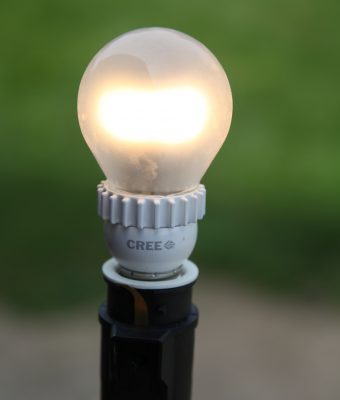
Light bulbs are changing, but the changes probably aren’t what you expect. Thankfully, misplaced early enthusiasm for compact florescent bulbs is being replaced by reality. If any new technology will realistically take over from incandescent bulbs, it’s going to have to offer a better lighting experience than compact florescent, lower operating costs and longer bulb life. This has been the mission of a man named Chuck Swoboda for the last 20 years, and his latest light bulb beats other alternatives hands down.
Mr. Swoboda is the CEO of a company called Cree, and the lighting this company has been perfecting for more than two decades is based on LED technology. LED stands for “light emitting diode”, and bulbs of this kind are not difficult to find on store shelves. What is rare is an LED bulb that combines reasonable cost, a bright and warm lighting experience, plus a real-world working life that’s long enough to make them economical. I’ve been living with several brands of LED bulbs in my home and workshop for more than five years, and though the light is good and the reliability has exceeded anything I’ve seen from incandescent bulbs, cost is typically too high. The once-typical price of $25 for a decent LED bulb is one reason I sat up and took notice when I first discovered Cree LED bulbs selling for about $15 each. Price is down to $11.97 at Home Depot Canada, and $9.97 in the US.
Curiosity led me to call Mr. Swoboda with questions, and that’s how I got the samples of Cree bulbs I’ve used for my research, beginning in June 2013. So far, I’m extremely impressed. Not only are the bulbs widely available in Home Depot, they give a warm, inviting light and have a 10 year warranty. Some of the glass globes did come unglued from the bulbs I first began using, but they were easy to glue back on with silicone caulking. Warranty on the bulb would get you replacements if you weren’t handy with a caulking gun. There’s also something else about the lighting quality of these bulbs that needs some explanation.
Ever since commercial lightbulbs were unveiled by Thomas Edison in December 1879, lighting output has always been expressed in watts. That’s why most of us have a sense that a 25 watt bulb is fairly dim and a 100 watt bulb is quite bright. One of the things that’s going to have to change as the world becomes illuminated by LEDs is trashing of that old wattage yardstick. The reason is because wattage referrers to the power consumption of the bulb, not its light output. The fact is, 95 out of the 100 watts consumed by your average incandescent lightbulb is wafted off as heat. Only 5 watts actually translates into light. But for now, the old wattage numbers are so firmly burned into our collective unconscious that you still find them applied to LED bulbs. The most impressive Cree bulb I’ve tested so far is their 60 watt equivalent. The actual power consumption is only 9.5 watts, but people still think in terms of wattage and light output. The Cree 60 watt equivalent bulb is actually underrated. It’s considerably brighter than any 60 watt incandescent bulbs I’ve used in my tests, and I’m told this is intentional.
“We’re trying to change a 100+ year history of disposable lighting”, explains Swoboda. “That’s why we’re aiming to create LED bulbs that are better and brighter than what people are used to now.” Assuming a 10 cent/kilowatt-hour electrical rate and average light bulb use, the Cree bulbs will pay for themselves in 2 or 3 years.
The best lighting technology will eventually rise to the top, and I’m convinced this will be some form of LED. At the moment the Cree bulbs are the best I’ve seen, and I expect them to give any competitor a run for their money. The real winner will be us consumers. We’re finally getting access to safe, long-lasting an economical light bulbs that make sense.
I’m on the record as opposing compact florescent bulbs right from the beginning. They’re dim, fragile, they don’t last that long and they release mercury when they break. But I love LEDs because they’re tough, they last a long time, and they get much less hot that incandescent bulbs.



